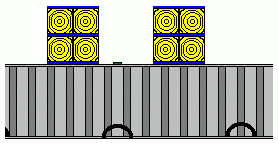Packing the "short slab" on a 20' flatrack
The flooring of flatracks is also designed to be uniformly loaded. However, unlike in box containers, loads can very readily be distributed on the strong bottom side rails of flatracks. This requirement presents no problems for cargo handling. If this requirement is met, no problems will arise with using either lifting gear or ground conveyors, such as forklift trucks.
In order to minimize the costs involved in securing, friction forces should be maximized. Using "sandwich" supports made from squared lumber with strips of friction-enhancing material laid on top and beneath is one way of achieving this.
 |
Sandwich support of the structure "friction-enhancing mat/wood/friction-enhancing mat" |
The friction-enhancing material used should comprise non-slip mats with a coefficient of sliding friction stated by the manufacturer of at least μ = 0.6. In the case of the large masses being loaded in the example, it must be borne in mind that, given the relatively small contact areas and consequently high pressures, the coefficient of friction will be reduced due to material compaction. It is not unusual for the coefficient of sliding friction to fall, for example, from μ = 0.6 to μ = 0.40. Accordingly, only the lower value should be used for calculation purposes. If contact areas are very small, the coefficient of sliding friction could drop even further. For this reason, supports with an excessively small surface area must not be used.
The greater the height of the selected support relative to its contact area, the greater are the forces which can be transferred into the load-bearing components (in the present case, the bottom side rails of the flatrack), but the greater too is the risk of tipping. Obviously, the opposite also applies: the smaller the height of the selected support relative to its contact area, the smaller are the forces which can be transferred into the load-bearing components of the means of transport, but the smaller too is the risk of tipping.
 |
|
| Different heights of sandwich supports at greater or lesser risk of tipping |
To maximize efficiency of operation, the necessary strength of the supports and thus their dimensions should be roughly calculated before loading. Anticipated shipping stresses and the best cargo securing methods are also determined. Once these parameters have been established, material strengths can be determined in accordance with the available lashing points and load-bearing components of the container.
In the present case, 14 cm x 14 cm squared lumber supports are selected and laid in pairs side by side and one on top of the other, so producing a high support and minimizing the risk of tipping, for example when the cargo is laid down. In order to minimize cargo securing effort, these supports are provided with strips of 10 mm thick non-slip mats to make "sandwich" supports.
 |
|
 |
Above and selective enlargement to the left:
Side view of "sandwich" support consisting of 14 cm x 14 cm squared lumber and strips of 10 mm thick friction-enhancing material |
 |
|
| Plan view of "sandwich" support consisting of 14 cm x 14 cm squared lumber and strips of 10 mm thick friction-enhancing material, arranged in a block of four |
The choice of 14 cm x 14 cm squared lumber and the manner in which they are arranged produces twelve squared lumber "beams", each of a height of 28 cm, which bear on the side rails of the flatrack. Due to compression by the heavy slab, the coefficient of sliding friction is assumed to be μ = 0.4.